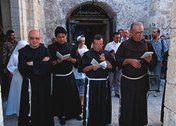All societies
have individuals whose job it is to guide or supplement the religious
practices of others. These religious leaders may be one of three
different types--priest
![]() ,
shaman
,
shaman
![]() , or
prophet
, or
prophet
![]() . In reality,
some individuals may at times have the functions of more than one of these categories.
. In reality,
some individuals may at times have the functions of more than one of these categories.
Priest
 |
|
|
Hindu priest leading |
|
A religious leader who is part of an organized religion is considered to be a priest or priestess. Of course, different religions have different terms for these individuals--they may be known as rabbis, ministers, mullahs, Imams, or something else. These individuals are the keepers of the sacred law and tradition. They are found mostly in large-scale societies.
 |
|
| Catholic monks on a
pilgrimage (members of a "priesthood") |
Priests are authorized by a priesthood, or some other religious organization, to perform religious rituals designed to influence the supernatural world and to guide the believers in their religious practices. Priests personally do not have supernatural powers at their command.
Priests are initiated and ceremonially inducted members of an established religious organization. That is, they are members of a priesthood. Their rank and function results from holding a religious office held by others before them.
Shaman
A shaman is a person who is not part of an organized religion and is in direct
contact with the spirit world, usually through a trance state. A shaman
has spirit helpers at his or her command to carry out curing, divining
![]() ,
and bewitching
,
and bewitching
![]() . Shamanistic power is acquired individually, usually in
physical and/or mental solitude and isolation from other humans. Spirits
or some other supernatural entities are revealed to the shaman and he or she
learns how to control them.
. Shamanistic power is acquired individually, usually in
physical and/or mental solitude and isolation from other humans. Spirits
or some other supernatural entities are revealed to the shaman and he or she
learns how to control them.
A shaman is essentially a religious entrepreneur who acts for human clients. He or she intervenes on behalf of a human client to influence supernatural beings to perform some act such as curing an illness or discovering the cause of an unexpected death. The shaman essentially acts as a middleman in this. In contrast, a priest's clients are the gods. A priest tells people what to do. A shaman tells the supernatural beings what to do. However, both shamans and priests are paid for their services with material things and/or prestige.
Shamans are common in small-scale societies. However, they do not completely disappear in large-scale societies that have organized religions. For example, in the Philippines and in some American Philippine communities, there are individuals who perform "spirit surgery." Evangelical Christian "faith healers" somewhat fit the definition of a shaman also. It depends on what they believe is the source of their "power." They are shamans if they personally have power to compel their God to cure people.
Prophet
A prophet is an individual who receives divine revelation concerning a restructuring of religion and usually of society as well. They call for dramatic change while priesthoods usually act as conservative forces in preserving long-standing traditions. Not surprisingly, prophets are usually outside of the priesthood and are seen by priests as irritating, disruptive trouble-makers. It is not unusual for prophets to come from humble or unknown origins.
When Jews and Christians think of prophets, people like Isaiah, Jeremiah, Ezekiel, and Daniel usually come to mind. However, the most striking example of a biblical prophet was Jesus. He essentially came out of nowhere as prophets often do and insisted on a radical restructuring of Judaism.
If a prophet is successful in convincing enough people that he or she is right, a new religion is usually established. That was the case with Mohamed and the beginning of Islam. Likewise, Joseph Smith's divine revelation and subsequent prophetic teaching in the 1830's and early 1840's led to the creation of the Church of Jesus Christ of Latter-Day Saints (the Mormons).
This page was last updated on
Tuesday, April 05, 2011.
Copyright 2000-2011by Dennis
O'Neil. All rights reserved.
Illustration credits